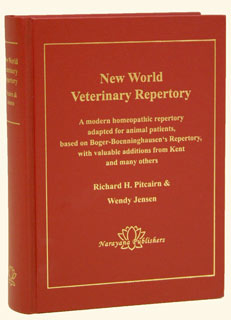The very first repertory designed exclusively for veterinary use. Of the more than 110 repertories published over the last two centuries*, this is the first that has been carefully constructed to be of special application to veterinary practice. Until now, veterinarians practicing the homeopathy of Hahnemann have used the repertories designed for human beings – Kent's, Boenninghausen's Therapeutic Pocketbook, Boger edition of Boenninghausen's repertory, The Synthetic Repertory, etc. These are excellent repertories for human use but can be a challenge to veterinarians for two reasons.
1. They contain large amounts of information, such as sensations, types of pains, and specific locations, that only humans can communicate.
2. Some of the most common non-human conditions are either minimally presented or completely absent from existing repertories.
Veterinarians Richard Pitcairn and Wendy Jensen, together with over 55 years' experience in exclusively homeopathic practices, bring their knowledge of animal conditions and the correspondingly most applicable rubrics to this unparalleled reference work. The Boenninghausen repertory, edited by Boger, was the foundation for the work because of its emphasis on physical conditions and its skillful use of modalities and concomitants that are so necessary in veterinary work. After editing out the non-applicable material, rubrics especially helpful in animal cases were added or enlarged – primarily from Kent's repertory, but also from other sources including Jahr, Boger, Allen, Hering and Boericke. Extensive cross references were also added to make the discovery of the most similar rubric much easier than ever before.
This work, the first of its type, will greatly enhance every homeopathic veterinarian's satisfaction and success in practice.
* Source: Robin Murphy. "Designing A New Repertory", The Journal of The Homeopathic Academy of Naturopathic Physicians, Fall 1993, Vol. VI, No. 3, page 22.
"I have been using the New World Repertory on a daily basis. Modeled after the Boenninghausen repertory, the NWR is similarly focused on physical symptoms, with the addition of rubrics specific to animal problems. Initially I thought it would just be applicable to my animal patients but have found it to be more concise and less bulky than many repertories, making it my first choice when initially repertorizing a case, be it animal or human. This repertory is a must for anyone who treats animals with homeopathy!"
Julie Matthews, DVM, CVA, CVH , York Maine
"I refer to your new repertory daily in my busy practice, and it has become my default reference when solving cases. Thanks to Richard and Wendy for all the labor involved in producing this great and useful tool for us to apply in practice."
Dr Todd Cooney DVM, CVH , Certified Veterinary Homeopath, Kokomo Indiana
"The NWVR has been invaluable in my homeopathic veterinary casework for both acute and chronic prescribing. This repertory is tailored for veterinary use by including applicable descriptive rubrics for symptoms we'd most likely see in our animal patients. Another helpful tool are the extensive cross references and inclusion of concomitants that can help refine an obscure symptom."
Marybeth Minter, DVM , Sedona
„I’ve been using this repertory since it came out a few years back, but in the digital version. It was carefully written from great source material on a great backbone (Boger-Boenninghausen, primarily), and painstakingly cleared of rubrics that are of no use to me in my animal patients. I can’t know anything about sensations, for example, because I can’t ask my patient what something feels like.
Drs. Pitcairn and Jensen painstakingly searched several reliable references to be sure that rubrics chosen were of clinical utility in animal work. Practitioners themselves, their bent was to make this repertory eminently useful.
The result is a finely honed, well organized tome that saves the busy practitioner time in his work, while broadening his understanding of what symptoms may apply to his case. The extensive cross references help me find rubrics that more accurately describe what I’m seeing in my animal patients.
I’m very happy to see the finely made hard bound version now, printed on high quality paper with section indents for easy access.”
Veterinär Homöopath Dr. Will Falconer
How often is there something really new brought out? There is now! For the very first time there is a repertory that has been carefully edited specifically for veterinary use. Dr. Wendy Jensen and Dr. Richard Pitcairn, together with 55 years of practical experience using homeopathy exclusively in the treatment of animals, have made a reference work you must have on your shelf.
Using the Boger-Boenninghausen repertory as a foundation, because this repertory is the most applicable to animal work, careful editing and additions from Kent's repertory and other sources have honed a tool both practical and very effective to use in practice.
The repertory was constructed in several stages. The first step was to remove all rubrics which could not be applied to animal patients, such as those relating to sensations or inner mental activities such as dreams and delusions. Then useful rubrics were added from Kent, Jahr, Boger, and Schwartz's Wound Repertory. Oftentimes Kent contained similar rubrics but had many more remedies, so these were added to the rubrics in Boenninghausen. The next step was to change the language to reflect quadruped anatomy, such as replacing ankle with hock and wrist with carpus. Finally, the cross references, which suggest rubrics with similar meanings, were greatly expanded, so that the busy practitioner could at a glance find the rubric with the best fit for the patient at hand.



 2.731.680 customers from 193 countries
2.731.680 customers from 193 countries




 Wishlist
Wishlist



